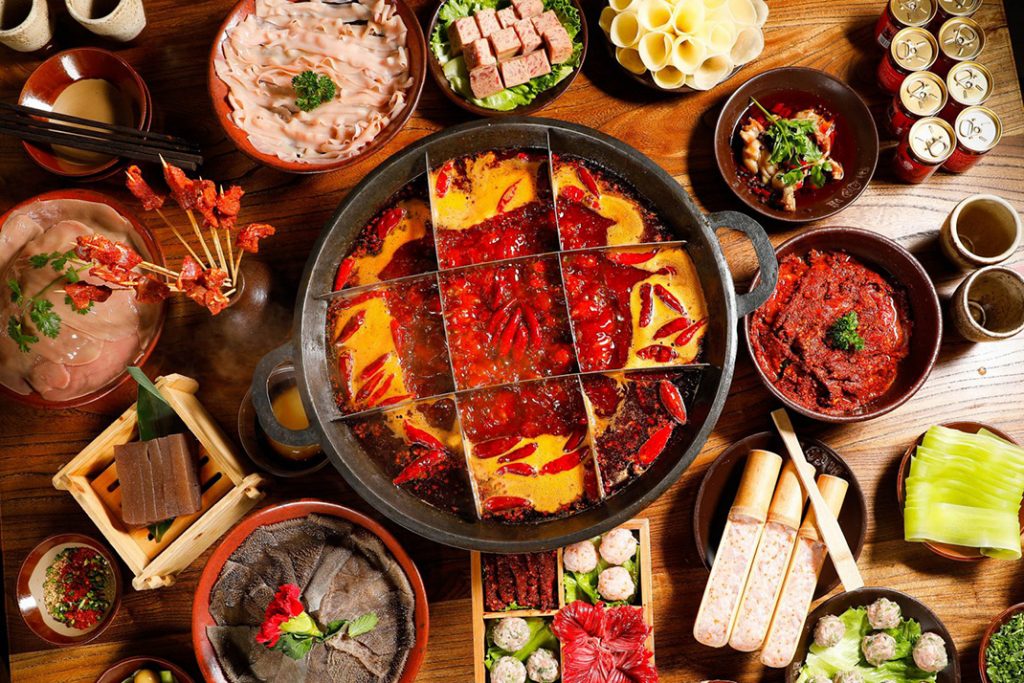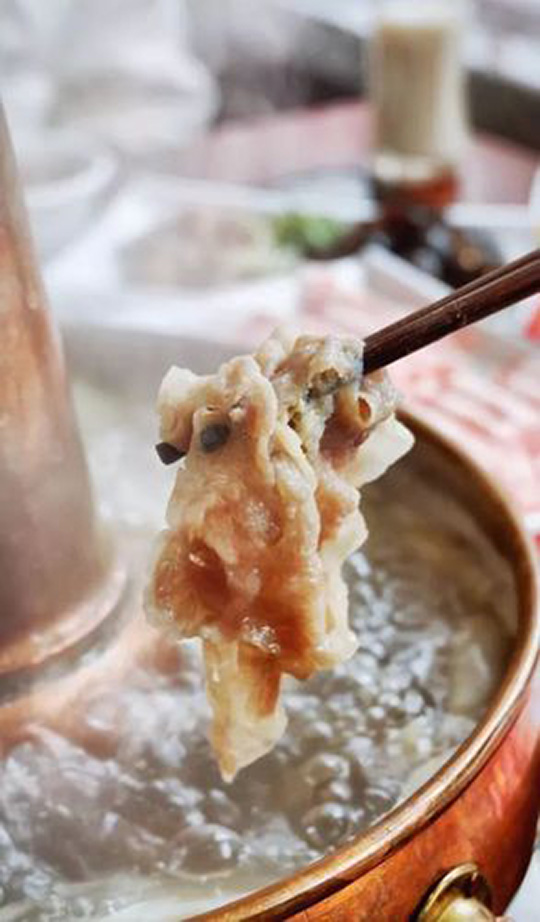The Transformation of Hotpot: Towards Convenience and/or Individualization?
Fueled by the pandemic during which people are more or less forced to conduct individual lives, it is no surprise that food exemplified by self-heated hotpot becomes so popular.
Written by Jack Linzhou Xing
Published on 11/01/2021
Hotpot is arguably one of the most famous and popular Chinese-style food. If you are asked to imagine a scene of having hotpot, you may suddenly think of several people – usually families or close friends – sitting around a big table, chatting and even screaming, with the steam from the pot curling around everyone.

But your impression may gradually change, especially given that the COVID-19 pandemic has stopped many people to enjoy food collectively outside the home. More and more people start to enjoy hotpot individually at home via buying the selfheating hotpot manufactured by famous food conglomerates such as Haidilao (海底捞).
Origin of hotpot: Fresh and convenient food for “laborious people”
The history of hotpot, as a quite simple and “primitive” way to cook foods, might be dated back to the late Han and the Three Kingdome era. According to Wei Shu 《魏书, people started to directly boil meat, chicken, and beef with copper tripods. Besides this explanation, there are many stories and folktales about the origin of hotpot in China, among which two are the most famous. The first one links hotpot with the great conqueror Genghis Khan: to let the highly mobile Mongolian army enjoy freshly cooked foods in a convenient way, he invented hotpot so that soldiers can simply make a fire and use a pot to boil sliced food quickly. This folktale is usually linked to the Beijing-style hotpot, or, commonly called “instant-boiled hotpot (shabu, shuanyangrou 涮锅).” Since the dominant ingredient in the Beijing-style hotpot is the lamb from the grassland in Inner Mongolia – exactly where Genghis Khan and his descent came from – the Beijing-style hotpot is also called “instant boiled lamb (shabu lamb, shuanyangrou 涮羊肉). ” Besides convenience, Beijing style hotpot emphasizes the freshness of lamb very much. Given the difficulty of obtaining fresh lamb from the northern grassland, Beijing-style hotpot could be seen as a high-end cuisine in the late Qing and the Republican period. For ordinary people, what they could do was more to put vegetables and other ingredients into Beijing-style hotpot without lamb.

Another more rigorous and realistic explanation is specifically pointing to the origin of Chongqing-style hotpot. In the late Qing and early Republican period, Chongqing was famous for its inland shipping and was full of boat trackers and port workers with low income but high demand for high-calorie food to support their heavy work. Under this situation, business people bought the cheap organs (xiashui, 下水) of pigs and cattle left out by butchers including stomachs, intestines, blood, and artery vessels (called huanghou 黄喉 by Chongqing people), boiled them with pungent and spicy soups to eliminate the gamey unpleasant smell and taste, and sold them to the workers. From both the folktale about Genghis Khan and the more realistic historical explanation of the origin of hotpot in Chongqing, one can see the original commonly accepted features of hotpot. First, it is a way to conveniently eat fresh food. Second, it is originally a food designated to “laborious people” whose work is mobile and involves heavy physical labor. Given that the so-called laborious people are usually lower working-class people with low income, the original hotpot can be seen as a highly “classed” food that balances freshness, convenience, and low cost.
Popularizing Hotpot: Collective Dining and Cultural Card
Given the difficulty to access fresh lamb suitable for Beijing-style hotpot especially in the southern part of China, Beijing-style hotpot remained a famous but not very widespread cuisine. In comparison, given the relative easiness to get the ingredients such as xiashui and chili pepper, and the spread of highly mobile Chongqing and Sichuan migrants, Chongqing- or broadly Sichuan-style hotpot, as a cuisine originally for lower-class people, spread nationwide since the late 1980s and early 1990s.
The typical scene of eating hotpot is suitable for collective parties or celebrations: With a big pot at the center of a big table, multiple people sit around the table and put different kinds of ingredients into the pot. When the ingredients are cooked and the pot is hot, multiple people put their chopsticks into the pot to grab food from the mixture.
Based on this typical scene, restaurants and media further promote hotpot by interpreting it from a cultural perspective. According to them, the mixture of ingredients in hotpot is a symbol of reunion (tuanyuan, 团圆) of families, solidarity (tuanjie, 团结) between friends and colleagues, and diversity (duoyuan, 多元) among different kinds of people. The orders and etiquette during eating hotpot – which is largely constructed after the nationwide popularity and did not exist when Chongqing-style hotpot was initially invented for lower-class workers – stands for the etiquette and mutual-respect between people in the society. Moreover, the hot temperature and – especially for Chongqing- and Sichuan- style hotpot – hot taste of hotpot stands for the interpersonal warmth of the society and the heated development of people’s career.
All these cultural interpretations further constructed hotpot further deepened the popular imagination that hotpot is more suitable for collective dining – people may even feel awkward when they go for eating hotpot alone. The famous hotpot chain Haidilao, to help the customer to relax when eating alone, usually puts a big teddy bear across his or her seat.
With its popularization as a form of collective dining, hotpot also became a cultural identity card for places famous for their hotpot. Chongqing became arguably the most famous city for hotpot. According to the report of BJ News, Chongqing contained a hotpot industry of RMB 50 billion consisting of 0.56 million workers and 13,215 hotpot restaurants within the urban area.[1] The first impression of many Chinese tourists to Chongqing is the spicy hotpot and the above-mentioned cultural values linked to hotpot.
Compared to the Chongqing-style hotpot which was promoted with the focus on collective dining, hot and spicy taste, and cultural values of interpersonal relationship, Beijing-style and Teochew-style hotpot emphasized freshness. While the Beijing-style freshness depends on the lamb from Inner Mongolia, the Teochew style hotpot depends on the beef from fresh daily slaughtered cattle. Given the difficulty of accessing fresh ingredients, they are not as widespread as the Chongqing- or Sichuan-style hotpot.
When emphasizing several particular features, the promotion of different kinds of hotpot also downplayed several other features. For the Chongqing-style hotpot, its origin as food for lower-class people was gradually erased. While Chongqing-style hotpot restaurants enjoying naming themselves after sailors, port workers, and boat trackers, they romanticized workers’ bold (haoshuang, 豪爽) lifestyle and rough but harmonious interpersonal relationship, but hid the fact that hotpot was made of originally left-out ingredients which only poor people could endure. Moreover, the promotion of different styles of hotpot coincide with each other in downplaying their feature of “convenience,” partly because convenience was usually related to low quality (see another article of instant noodles by Xiaomeng Liu).
“Domesticating” Hotpot: The Hidden Development of Convenience
Despite the downplay of the convenience feature in the period from the late 1980s to early 2000s, hotpot chains never stopped exploiting this feature. Chongqing-style hotpot is a pioneer in this direction. Given that the condiments (including chili peppers, Sichuan peppers, garlic, salts, etc.) of Chongqing-style hotpot are precooked in beef tallow, restaurants made instant bags of hotpot seasoning (huoguo diliao, 火锅底料) in the shape of bricks made of solidified beef tallow. Slightly differently, the famous hotpot chain Little Sheep (小肥羊) made hotpot seasoning into powder, while Haidilao made their product as a sauce.
All these inventions, starting to be popular in the mid-2000s, fully exploited the convenience of the already convenient cuisines of hotpot – now people can simply buy hotpot seasoning, boil them in waters with a pot, add meat, vegetable, and other raw ingredients bought from the market, and enjoy hotpot at home.
“Individualizing” Hotpot: Self-heated Hotpot as a Fashion for “Lazy People”
Starting from the 2010s, the convenience feature of hotpot was no longer hidden, but developed towards a new level. Simultaneously, even the collective eating style of hotpot has been gradually changing. Haidilao, as a pioneer of this trend, invented the self-heated hotpot. Small plastic pots of hotpot are sold with a small bag of a mixture of quick lime, iron powder, and other ingredients. When the user pours water onto the small bag, the bag can heat the hotpot in 15 minutes and allow the user to enjoy the food.
Self-heated hotpot has two features. First, the seller provides not only the hotpot seasoning but also the main ingredients. This, combined with the self-heating function, makes self-heated hotpot as convenient as instant noodles. Second, due to safety concerns, the size of the self-heating bag and correspondingly the size of the hotpot is limited. This makes each hotpot only enough for one person.
The invention of self-heated hotpot fundamentally changed hotpot. The feature of convenience is largely emphasized, while the collective eating style was made impossible. Correspondingly, the abovementioned common cultural values attached to hotpot experienced similar changes. The interpersonal values are no longer emphasized, but the individual value typical among young students and young whitecollar middle-class people is emphasized. In the advertisement of Haidilao, one can first see the words “anytime and anywhere, accompanying you (suishi suidi, genni zou de, 随时随地,跟你走的),” which emphasizes mobility of “you” alone and the extreme convenience. When addressing the eating scenes, the advertisement mentions “feeding yourself when working overtime (jiaban xiaoqi, kaolao ziji, 加班小憩,犒劳自己),” and “staying individually at home on weekends, enjoy convenient and quick food (zhoumo zhaijia, fangbian kuaijie, 周末宅家,方便快捷),” which both emphasize the typical individual, young white-collar middle-class style of work and lifestyle.

In comparison, given the emphasis on the freshness of Beijing- and Teochew-style hotpot, self-heated hotpot, represented by Haidilao’s invention, was made predominantly based on Chongqing- and Sichuan-style hotpot.
In this sense, self-heated hotpot turned hotpot from a traditional cuisine originally designed for working-class people and collective eating into a fashion cuisine designed for individual white-collar middle-class young people, and simultaneously sacrificed the requirement of freshness.
Summary: Taste, Convenience, Class, and Culture
The transformation of hotpot is a history of entanglement between taste, convenience, class, and culture. The origin of Beijing-style and Teochew-style hotpot, with a mild taste, set high requirement on the freshness of ingredients, and thus remain as a relatively high-end local cuisine. In comparison, the origin of Chongqing-style hotpot used the spicy taste trend to balance freshness, convenience, and cheapness, so as to cater to the need of lower working-class people. Interestingly, such features of the Chongqing- and Sichuan-style hotpot enabled it to spread nationwide, and evolved into various eating styles. While its more traditional version downplayed the feature of convenience but emphasized collective eating and the corresponding collective cultural values in its promotion, the more innovative version, i.e., the self-heated hotpot, emphasizes convenience and the corresponding individual young white-collar middle-class lifestyle. In this trajectory of development, the transformation of the cultural implication of convenience played a very important part. Originally, convenience was linked with a compromise to lower quality in need of speed, which corresponded to the lifestyle of lower working-class people with busy work and little income. With the development of middle-class white-collar workers in China, and the popularity of the ideas related to individualization, convenience gradually started to indicate values of individual independence, fashion, and mobility in lifestyle. Fueled by the pandemic during which people are more or less forced to conduct individual lives, it is no surprise that food exemplified by self-heated hotpot becomes so popular.
Footnote
- Qin, Che, and Weijia Li. 2020. “Buye cheng Chongqing: Buzhi shi kongqi zhong miman zhe huoguo de weidao (Chongqing, a city without nights: Beyond the smell of hotpot in the air).” Accessed Jan. 1, 2021: http://www.bjnews.com.cn/feature/2020/01/30/681609.html#:~:text=%E5%BE%88%20%E5%B0%91%E6%9C%89%E4%BA%BA%E8%83%BD%E8%AF%B4,%E5%B0%%20B1%E6%9C%89%E4%B8%80%E5%AE%B6%E7%81%AB%E9%94%85%E5%BA%20%97%E3%80%82.
